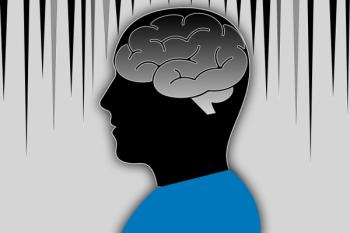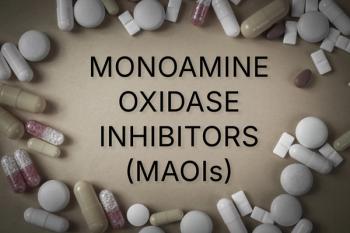
- Vol 42, Issue 1
Demystifying Lithium Therapy—A Primer for Clinicians: Lithium-Related Polyuria, Part 2
Key Takeaways
- Amiloride is recommended over NSAIDs or thiazides for treating lithium-related polyuria due to its efficacy in reducing lithium accumulation in principal cells.
- Early morning urine osmolality and 24-hour fluid intake recollection are practical tools for screening nephrogenic diabetes insipidus in lithium-treated patients.
In this CME article, learn more about alternative methods to screen for lithium-related polyuria and how to implement amiloride for lithium-related polyuria.
CATEGORY 1 CME
Premiere Date: January 20, 2025
Expiration Date: July 20, 2026
This activity offers CE credits for:
1. Physicians (CME)
2. Other
All other clinicians either will receive a CME Attendance Certificate or may choose any of the types of CE credit being offered.
ACTIVITY GOAL
To inform readers of the recent developments with lithium as they relate to renal issues.
LEARNING OBJECTIVES
1. To educate clinicians about alternative methods to screen for lithium-related polyuria, including early morning urine osmolality and the 24-hour fluid intake recollection.
2. To describe how to implement amiloride for lithium-related polyuria, why it is superior to nonsteroidal anti-inflammatory medications or thiazides, and when to use adjunctive acetazolamide, a carbonic anhydrase inhibitor.
TARGET AUDIENCE
This accredited continuing education (CE) activity is intended for psychiatrists, psychologists, primary care physicians, physician assistants, nurse practitioners, and other health care professionals who seek to improve their care for patients with mental health disorders.
ACCREDITATION/CREDIT DESIGNATION/FINANCIAL SUPPORT
This activity has been planned and implemented in accordance with the accreditation requirements and policies of the Accreditation Council for Continuing Medical Education (ACCME) through the joint providership of Physicians’ Education Resource,® LLC, and Psychiatric Times®. Physicians’ Education Resource, LLC, is accredited by the ACCME to provide continuing medical education for physicians.
Physicians’ Education Resource, LLC, designates this enduring material for a maximum of 1.5 AMA PRA Category 1 Credits™. Physicians should claim only the credit commensurate with the extent of their participation in the activity.
This activity is funded entirely by Physicians’ Education Resource, LLC. No commercial support was received.
OFF-LABEL DISCLOSURE/DISCLAIMER
This accredited CE activity may or may not discuss investigational, unapproved, or off-label use of drugs. Participants are advised to consult prescribing information for any products discussed. The information provided in this accredited CE activity is for continuing medical education purposes only and is not meant to substitute for the independent clinical judgment of a physician relative to diagnostic or treatment options for a specific patient’s medical condition. The opinions expressed in the content are solely those of the individual faculty members and do not reflect those of Physicians’ Education Resource, LLC.
FACULTY, STAFF, AND PLANNERS’ DISCLOSURES AND CONFLICT OF INTEREST MITIGATION
None of the staff of Physicians’ Education Resource, LLC, or Psychiatric Times or the planners or the authors of this educational activity have relevant financial relationship(s) to disclose with ineligible companies whose primary business is producing, marketing, selling, reselling, or distributing health care products used by or on patients.
For content-related questions, email us at
for questions concerning the accreditation of this CME activity or how to claim credit, please contact
HOW TO CLAIM CREDIT
Once you have read the article, please use the following URL to evaluate and request credit:
(This is the second part of a 2-part series on lithium.
Polyuria has a direct impact on a variety of intracellular systems that result in vasopressin insensitivity and downregulation of water-absorbing aquaporin 2 (AQP2) channels.1-4 In addition to impaired urine concentrating ability, other short- and long-term consequences of this process (if not properly addressed) include the risk of lithium refusal by the patient,5 renal microcyst formation, interstitial fibrosis, and tubular atrophy.3 The key to understanding this phenomenon relates to 1 basic fact: Lithium readily enters principal cells via the epithelial sodium channel (ENaC), but lithium does not easily exit these cells, leading to intracellular accumulation.1,2 ENaC is a trimeric structure with β and γ gamma subunits that are important for trafficking to the apical membrane surface, and either an α or δ subunit is used to form the ion channel.6 The ENaC structure present in principal cells contains α, β, and γ subunits. Unfortunately, for those forms of ENaC, which possess a subunits, lithium has 1.6 times greater affinity than sodium (Na+).4 Once inside the principal cell, Na+ removal relies on the basilar Na+/K+-ATPase and, to a lesser extent, on the Na+/H+ exchanger 1 (NHE1). However, lithium is a poor substrate for the Na+/K+-ATPase pump, leading to high intracellular levels due to slow removal via NHE1.3
Armed with this understanding of lithium-related polyuria pathophysiology, clinicians must become adept at screening for signs and symptoms of nephrogenic diabetes insipidus (NDI) and using evidence-based methods to manage the problem.7,8 Two common issues impede the detection and treatment of lithium-related partial or full NDI: the impracticality of obtaining repeated and accurate 24-hour urine specimens and a lack of clinician knowledge on the best means to treat lithium-related NDI.8 Options for the 24-hour urine collection are discussed here, but decades of animal and human studies have conclusively shown that lithium dose reduction or watchful waiting to see whether tolerance develops to this adverse effect are not effective methods to manage this problem, whereas the data strongly support the use of the ENaC inhibitor amiloride over nonsteroidal anti-inflammatory drugs or thiazide diuretics.2,9-15 Unfortunately, the use of amiloride is not common, as attested to by observational data from clinical practice.
A group associated with University Hospital Dublin explored how clinicians routinely manage NDI in a surveillance study of all lithium-treated adult outpatients seen at Cluain Mhuire Community Mental Health Services over 1 month.8 Investigators identified 138 individuals and asked them to complete a 24-hour urine collection; early morning urine osmolality (EMUO); and a battery of questionnaires on polyuria, nocturia, and polydipsia (
Exploring Important Polyuria Screening Tools
One would presume that any patient who experiences the need to urinate frequently would report this vociferously to the treating clinician, but studies have shown that unless there is direct inquiry, lithium-related polyuria is often underreported.16 The most important tool in addressing this problem is asking questions about increased thirst, the need to consume more fluids, and urinary frequency at every routine office visit for every patient treated with lithium.17 The point is to convey that this is a treatable problem and that you wish to hear about it so it can be properly managed, even if prior clinicians indicated that nothing can be done. Having elicited a complaint regarding urinary frequency that appears connected to lithium, the conundrum is how to measure the extent of this problem without undue patient burden. The practical issue confronting patients and clinicians is that the gold standard test for quantifying the extent of a urine concentration defect is the cumbersome 24-hour urine collection.18 As part of a strategic attempt to find more feasible means for quantifying NDI severity, this same group from Dublin noted previously recruited 179 patients treated with lithium from 2 centers to complete a battery of tests. Of this sample, 122 completed an accurate 24-hour urine collection and 79 completed all assessments, including questionnaires on polyuria, polydipsia, and nocturia; the 24-hour urine collection; EMUO; and a 24-hour fluid intake recollection (FIR).7 As urine is maximally concentrated in the morning, EMUO was employed as a surrogate marker for the extent of the urine concentration defect.19 (For reference, a normal EMUO after 12- to 14-hour fluid restriction is ≥ 850 mOsm/kg.) The patient’s recall of fluid intake over 24 hours (ie, FIR) was added to assess the reliability of this self-report measure and its correlation with objective tests.
The patients had a mean age of 57 ± 15 years, a mean duration of lithium use of 13 ± 10 years, and 58% were women.7 The investigators found that FIR values of less than 2000 mL/24 hours were associated with a very low likelihood ratio of polyuria (LR, 0.18), whereas FIR values of greater than 3500 mL/24 hours had a very high likelihood (LR, 6.1) (
There are some practical conclusions that must be considered when examining these results. Certain patients clearly had difficulty tracking accurate 24-hour fluid intake, as some whose urine output exceeded 3000 mL/24 hours reported ingesting less than 3000 mL in that same time frame. Proper patient instruction about the need to record all fluids (not just water) is important. To simplify obtaining an EMUO, all clinicians should amass a supply of sterile urine sample containers and provide several of these to the patient to obviate an extra visit to the lab just to procure a specimen cup. It is crucial to reinforce the need to provide the EMUO specimen upon awakening and before any fluids are consumed. Although very low EMUO values in the Dublin study (ie, < 300 mOsm/kg) were highly correlated with polyuria, the authors noted that an EMUO greater than 400 mOsm/kg was associated with lower risk (LR, 0.38). As an EMUO less than 600 mOsm/kg is abnormal and consistent with partial NDI, the implication is that this may not have been a valid early morning specimen or that the patient’s 24-hour urine volume was not yet greater than 3000 mL but may still be above their baseline. If the patient is reporting increased urination and there is doubt about whether the EMUO was done correctly, it is easily repeated. The EMUO sample is also stable at room temperature for up to 5 days, so it can be delivered to the lab at the patient’s convenience.19
Amiloride: The ENaC Inhibitor to the Rescue
Once the patient’s report of urinary frequency or thirst is registered and the NDI severity is quantified with EMUO (and possibly 24-hour FIR), the initial treatment is amiloride. Amiloride was developed in 1967, and by the early 1980s, it became clear that it was a specific inhibitor of those ENaC isoforms possessing a subunits,20,21 leading to the publication of a controlled trial of amiloride for lithium-related polyuria in The New England Journal of Medicine in 1985.22 This was followed by case reports and reviews of amiloride use for this purpose,23-25 with a 2008 double-blind, placebo-controlled, crossover study demonstrating that only 6 weeks of amiloride treatment, starting at 5 mg once daily (qD) for 1 week and then 5 mg PO twice daily (BID), was sufficient to induce a mean 164.5% ± 8% increase in urine osmolality and 104% ± 32% increase in AQP2 water channel excretion (a measure of AQP2 channel density) among subjects with full NDI (mean baseline urine osmolality, 298 mOsm/kg).12 Although the sample was small (9F/2M), these patients (mean age, 58 years) had 20 ± 3 years of lithium exposure, illustrating the efficacy of amiloride even in long-standing lithium-related NDI. Amiloride not only ameliorated the urine concentrating defect by blocking lithium entry into principal cells via ENaC, but it also did not alter lithium levels12; moreover, animal models have found that amiloride moderates the progression of lithium-related interstitial fibrosis.26 Given this array of beneficial effects, a 2020 review authored by a nephrologist opined whether amiloride should be considered prophylactically in all patients treated with lithium as a means to prevent renal dysfunction.18 Although the literature does not yet support the prophylactic use of amiloride, early identification and treatment of polyuria with amiloride must be offered to all patients treated with lithium.
Some Practical Issues in Using Amiloride
Amiloride selectively blocks ENaC, thereby decreasing intracellular lithium levels; however, at least 6 weeks is needed to realize amiloride’s clinical effect once the lithium is removed from principal cells, the vasopressin response normalizes, and the AQP2 channel density is restored.12 As noted in the clinical trial referenced previously, an initial starting dose of 5 mg qD for 1 week and then 5 mg BID for 5 weeks is reasonable. Future amiloride dose changes can be made every 6 to 8 weeks. Amiloride does cause potassium retention and should not be used in patients with very high baseline serum potassium levels (> 5.5 mEq/L) or in those on potassium supplements. One should also start amiloride cautiously (eg, 5 mg qD) in the presence of other potassium-sparing diuretics (spironolactone, triamterene), angiotensin-converting enzyme inhibitors, or angiotensin receptor II blockers. A baseline serum potassium must be obtained in patients on those other medications, and routine electrolyte monitoring must be performed after 2 to 3 weeks on each new dose of amiloride and routinely thereafter.27 Amiloride does cause some sodium wasting, but less so than the diuretic hydrochlorothiazide (HCTZ). For that reason, one should check sodium levels 6 weeks after starting or adjusting amiloride doses and monitor electrolytes every 6 months (along with lithium levels) to check for hyponatremia (and hyperkalemia in patients on interacting medications). Amiloride has a half-life of 6 to 9 hours and is typically dosed twice daily, with the peak effect occurring 6 to 10 hours post dose.27 The maximal daily dose is 10 mg BID.
Acetazolamide: When Amiloride Is Not Effective Enough
Sadly, many patients treated with lithium may have experienced NDI for years, with the net result that principal cell density has diminished due to lithium toxicity, and the remaining principal cell population may be insufficient to adequately reabsorb water and restore normal urine concentrating ability.28,29 Although the nonsteroidal medication indomethacin and the diuretic HCTZ have shown benefit for lithium- related polyuria,9-11,13,14 prolonged nonsteroidal use poses a risk for bleeding and renal injury. Moreover, unlike amiloride, HCTZ does not act as an ENaC but instead is an inhibitor of the Na+-K+-Cl– cotransporter (NCC), and thus does not directly address the issue of lithium entering principal cells via ENaC.13 HCTZ also induces significant sodium wasting, resulting in risk for lithium toxicity if serum sodium and lithium levels are not followed closely and lithium dosing adjusted.30,31 Because HCTZ is not an ENaC inhibitor, investigators sought to understand the mechanism by which it reduced urinary volume using animal models of lithium-induced NDI. The explanation for this effect was unclear until research with mouse knockout (KO) models lacking the thiazide-sensitive NCC found that HCTZ also reduced urine volume in these NCC KO mice.13 Because NCC is the primary target for thiazide-type medications, it was postulated that a secondary property, carbonic anhydrase inhibition (CAI), mediated thiazide effects on lithium-induced NDI in NCC KO animals.13,32 Thiazide diuretics were chemically derived from CAIs and retained some of their properties. Subsequent studies with the CAI acetazolamide confirmed that CAI is an effective mechanism for lithium-induced NDI, comparable to the effects of an amiloride/thiazide combination but without the thiazide-related risks for hyperkalemia, hyponatremia, and increased lithium levels.28,29,32
Following those animal studies, several case reports emerged documenting clinical response to adjunctive acetazolamide in patients with lithium-related NDI who had an inadequate response to amiloride or HCTZ.33,34 Although there are limited data from prospective human studies, these clinical case reports and animal data suggest that acetazolamide should be the option for lithium-related NDI not responding to maximum daily doses of amiloride.35 Because acetazolamide is not an ENaC inhibitor, it does not improve urine concentrating ability and therefore is never the primary treatment, but it can be used adjunctively to reduce urinary volume when amiloride is insufficient to push EMUO above 600 mOsm/kg and decrease urinary frequency.28,29,34 Acetazolamide is also dosed twice daily, starting at 250 mg PO BID initially. The effects may be seen a bit more quickly than with amiloride, but allow at least 2 weeks before rechecking 24-hour FIR and EMUO and increasing the dose to 750 mg/d. The maximum daily dose is 500 mg BID. It is crucial to remember that acetazolamide decreases lithium levels by 31%, so the level should be rechecked after 2 weeks on each new dose of acetazolamide, and the lithium dose adjusted based on the new level.36
Concluding Thoughts
Patient complaints of lithium-related polyuria should always be elicited and promptly addressed using practical tools, such as EMUO, the 24-hour FIR, and the ENaC inhibitor amiloride. Implementing routine screening procedures into practice, providing patients with a supply of specimen cups, and timely use of amiloride and, occasionally, adjunctive acetazolamide are the modern means to manage this important lithium-related adverse effect. Knowing that untreated polyuria may eventuate into other forms of renal dysfunction and understanding why amiloride is the specific treatment for this problem hopefully will instill confidence in prescribing lithium to patients with a history of mania (and other mood disorders).
Dr Meyer is a voluntary clinical professor of psychiatry at the University of California, San Diego.
References
1. Grünfeld JP, Rossier BC.
2. Kortenoeven MLA, Li Y, Shaw S, et al.
3. Davis J, Desmond M, Berk M.
4. Vallée C, Howlin B, Lewis R.
5. Öhlund L, Ott M, Oja S, et al.
6. Ji HL, Bishop LR, Anderson SJ, et al
7. Kinahan JC, NiChorcorain A, Cunningham S, et al.
8. Kinahan JC, Ní Chorcoráin A, Cunningham S, et al.
9. Thomsen K, Schou M.
10. Martinez EJ, Sinnott JT 4th, Rodriguez-Paz G, Oehler RL.
11. Kim GH, Lee JW, Oh YK, et al.
12. Bedford JJ, Weggery S, Ellis G, et al.
13. Sinke AP, Kortenoeven ML, de Groot T, et al.
14. Filippone EJ, Ruzieh M, Foy A.
15. Vaz de Castro PAS, Bitencourt L, de Oliveira Campos JL, et al.
16. Pradhan BK, Chakrabarti S, Irpati AS, Bhardwaj R.
17. Meyer JM, Stahl SM. The Lithium Handbook: Stahl’s Handbooks. Cambridge University Press; 2023:452.
18. Schoot TS, Molmans THJ, Grootens KP, Kerckhoffs APM.
19. Sureda-Vives M, Morell-Garcia D, Rubio-Alaejos A, et al.
20. Cuthbert AW, Wong PY.
21. Paris S, Pouysségur J.
22. Batlle DC, von Riotte AB, Gaviria M, Grupp M.
23. Kosten TR, Forrest JN.
24. Wells BG.
25. Finch CK, Kelley KW, Williams RB.
26. Kalita-De Croft P, Bedford JJ, Leader JP, Walker RJ.
27. Amiloride. Package Insert. Par Pharmaceutical Inc; 2022.
28. de Groot T, Sinke AP, Kortenoeven ML, et al.
29. de Groot T, Doornebal J, Christensen BM, et al.
30. Mehta BR, Robinson BH.
31. Dorevitch A, Baruch E.
32. Sands JM. Water, water everywhere: a new cause and a new treatment for nephrogenic diabetes insipidus. J Am Soc Nephrol. 2016;27(7):1872-1874.
33. Gordon CE, Vantzelfde S, Francis JM.
34. Macau RA, da Silva TN, Silva JR, Ferreira AG, Bravo P.
35. Sands JM, Klein JD.
36. Thomsen K, Schou M.
Articles in this issue
11 months ago
10 Clinical Pearls for Treating Mood Disorders11 months ago
How a Psychiatrist Writes a Poem...11 months ago
Discontinuing Antipsychotics11 months ago
Neuroplasticity in ActionNewsletter
Receive trusted psychiatric news, expert analysis, and clinical insights — subscribe today to support your practice and your patients.













